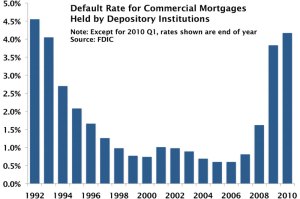
Commercial Real Estate Default Rates Rise
The default rate for commercial real estate mortgages held by the nation’s banks increased from 3.8 percent in the fourth quarter of 2009 to 4.2 percent in the first quarter of 2010. This is the highest default rate reported since 1992, the first year for which the relevant F.D.I.C. data series is available for the quarterly analysis undertaken by the team at Real Capital. At its cyclical low in the first half of 2006, the commercial mortgage default rate was just 0.6 percent.
Year over year, the default rate-which is defined for our analysis as the percentage of loans that are past due 90 days or more or that are in non-accrual status-is up sharply, from 2.3 in the first quarter of 2009. But quarter to quarter, the first most recent increase in the default rate is the smallest since the fourth quarter of 2008. As the pace of default increases has slowed, the net charge-off rate for commercial mortgages has moderated as well. Net charge-offs decreased by 31 bps in the first quarter, to just below 1.0 percent.
As of the first quarter, $45.5 billion of bank-held commercial mortgages were in default, up $3.7 billion from the fourth quarter of 2009. While the volume of mortgages in default continued to rise, the quarter-to-quarter increase of $3.7 billion was the smallest one-quarter rise since the fourth quarter of 2008, consistent with the percentage increase.
Differences Across Bank Sizes
Commercial mortgage performance varies measurably by bank size. The largest class of banks (institutions with $10 billion or more in assets) accounted for 48 percent of all bank-held commercial mortgages and had the highest default rate, at 5 percent. The combined multifamily and commercial real estate concentration at these institutions is relatively low, however, at 11.9 percent.
Smaller and medium-sized institutions (with total assets ranging between $100 million and $10 billion) held 50.2 percent of all bank-held commercial mortgages. Default rates for commercial mortgages held by these banks were 150 basis points lower that at their larger peers. But at 33.4 percent, their combined multifamily and commercial real estate concentration was much higher.
Multifamily Real Estate Default Rates
As compared to commercial real estate mortgages, multifamily mortgages held by banks have exhibited consistently higher default rates. In the first quarter of 2010, the multifamily mortgage default rate increased by 21 basis points, from 4.4 percent to 4.6 percent. This default rate was the highest on record, surpassing the previous high of 4.2 set in 1993.
The default rate for multifamily mortgages surpassed that of commercial mortgages in the second quarter of 2008 and has remained marginally higher over the ensuing period. The default rate on multifamily mortgages has nearly doubled over the past year, rising from 2.4 percent to 4.6 percent. At its cyclical low in the first half of 2005, the multifamily mortgage default rate was just over 0.2 percent.
Charge-offs for multifamily mortgages fell in the first quarter, from 1.7 at the end of 2009 to 1.1 percent. As with commercial mortgages, however, the first-quarter charge-off rate was well above its previous cyclical lows.
In total, $9.9 billion of bank-held multifamily mortgages were in default in the first quarter, up $0.6 billion from the fourth quarter of 2009. While the volume of multifamily mortgages in default continues to rise, the first quarter registered the smallest one-quarter increase since late 2008.
New York Banks Fare Better
In comparison with the national trends, banks with principal offices in the New York area are reporting fewer defaults in their commercial mortgage portfolios. Across 117 New York lenders included in the analysis, the average first-quarter default rate was 3.3 percent. Similarly, the multifamily default rate at New York lenders averaged 3.5 percent. Deterioration in construction and development lending has persisted, with the average default rate rising to 12.8 percent in New York.
What’s Ahead
The outlook for legacy loan portfolios remains challenging. While conditions in the economy and labor markets show early signs of improvement, commercial real estate fundamentals remain weak. Rising default rates reflect challenges in refinancing loans at maturity given lower property values and constraints on credit availability, but they also reflect property owners’ difficulties in meeting recurring principal and interest obligations during the life of the loan.
Reflecting differences in loan quality across lender groups, the high default rate for bank-held multifamily mortgages is in contrast with the significantly lower distress rates for multifamily mortgages at Fannie Mae and Freddie Mac. In spite of the challenges in their single-family lending portfolios, the government-sponsored enterprises’ multifamily portfolios continue to show exceptional health. At Freddie Mac, for example, the 60-day delinquency rate for multifamily mortgages in the first quarter was just over 0.2 percent. Needless to say, there are substantial differences in default and loss experience even across regional banks of similar size and with similar lending footprints.
According to the most recent Federal Reserve Senior Loan Officer Opinion Survey on Bank Lending Practices, 85.7 percent of all medium and large banks, and 96.3 percent of all small banks, reported that credit standards for commercial real estate loans (including land and development loans) were unchanged from the fourth quarter of 2009 to the first quarter of 2010. These results reflect that in spite of rising defaults, credit standards for new lending activities are stabilizing and a number of banks have increased their net commercial real estate positions in recent months.
Going forward, we expect that moderating legacy mortgage default rates will coincide with improving new lending conditions. This expectation is bolstered in New York by the relatively healthier position of the regions’ balance sheet.
schandan@rcanalytics.com
Sam Chandan, Ph.D., is global chief economist and executive vice president of Real Capital Analytics and an adjunct professor of real estate at Wharton.


